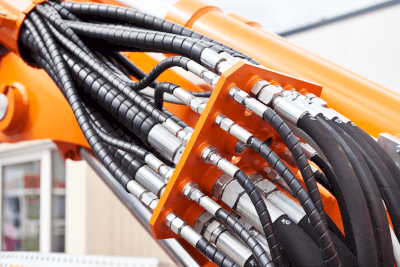What Is a Hydraulic Hose?

A hydraulic hose is a hose that serves as a flow path for hydraulic fluid in hydraulically powered equipment.
Hydraulic power is the power generated by a hydraulic pump that converts power from an engine or motor. It is mainly used in construction equipment because even a small pump can generate a large amount of power.
Unlike water hoses, they are designed to withstand higher pressures than those of ordinary household water supply systems. In recent years, hydraulic hoses are increasingly being used as an alternative to conventional hydraulic piping, such as steel pipes and rigid pipes.
Uses of Hydraulic Hoses
As an essential product for hydraulic equipment and flexible piping that can be used in high-pressure environments, hydraulic hoses are used in construction equipment such as hydraulic excavators and wheel loaders, and in factory equipment such as injection molding machines and die-casting machines.
Comparing hydraulic hose with hydraulic piping, hydraulic hose is more flexible and lightweight, and therefore has a higher degree of freedom.
Principle of Hydraulic Hoses
Hydraulic hose is used as the hydraulic oil flow path for hydraulic power and is made of thicker rubber hose compared to the water hose used in ordinary households. Hydraulic pipes used as flow paths for hydraulic power are subject to fatigue failure, such as cracking, due to vibration caused by the rotation of hydraulic pumps. Maintenance is also difficult in such cases.
Hydraulic hoses, on the other hand, are easier to maintain than hydraulic pipes. In recent years, hoses that can withstand high loads have been produced, depending on the application and type of use, and hydraulic hose is increasingly replacing hydraulic pipe.
How to Select Hydraulic Hoses
The following are the six minimum items that must be checked when selecting a hydraulic hose:
- Confirm the type of fluid used.
- Select the inside diameter of the Hydraulic Hose based on the flow rate and velocity of the fluid to be used.
- Check the maximum working pressure.
- Check the temperature and ambient temperature of the fluid to be used.
- Check the minimum bending radius of the Hydraulic Hose after confirming its installation position.
- Check the type of fittings
Incorrect selection of hydraulic hose can cause problems such as damage to the hydraulic hose and the inability of the machine to perform at its full capacity. To select the right Hydraulic Hose, it is necessary to have extensive knowledge of fluids, fittings, and hydraulic equipment.
Other Information on Hydraulic Hoses
1. Fittings
A hydraulic hose is subjected to high pressure loads, so it is common to use special fittings for joints with hydraulic equipment. The role of the fitting is to prevent the hydraulic hose from disconnecting due to the high pressure of hydraulic pressure.
For example, taking water pressure as an example, when a hose is connected to a faucet to let out water, if the faucet is turned fully open and water is let out under high water pressure, the holding force of the hose will be outmatched by the force of the hose and faucet to let out water, causing the hose to disconnect. To prevent this, the faucet and hose should be banded or wired together.
Since hydraulic pressure is higher than that of water, the nipple and socket of a fitting are combined to make it structurally stronger. Advantages of fitting fittings include easy connection and disconnection, no need for seals, etc. as they can be combined as a single unit, and flexible piping as the angle can be freely adjusted by the degree of tightening.
2. Installation and Maintenance
Hydraulic hoses are flexible and are often attached to moving parts. The design must take into account the possibility of damage due to contact with the peripheral equipment of the machine. Since the hydraulic oil flowing inside the hose is under high pressure, if the hose is damaged, the hydraulic oil will be sprayed out at high pressure. Since it is very dangerous for workers to be exposed to high-pressure oil, hydraulic hoses should be protected as necessary.
Hydraulic hoses are mainly made of rubber, and it is generally recommended to replace them once every two years to prevent damage due to deterioration.